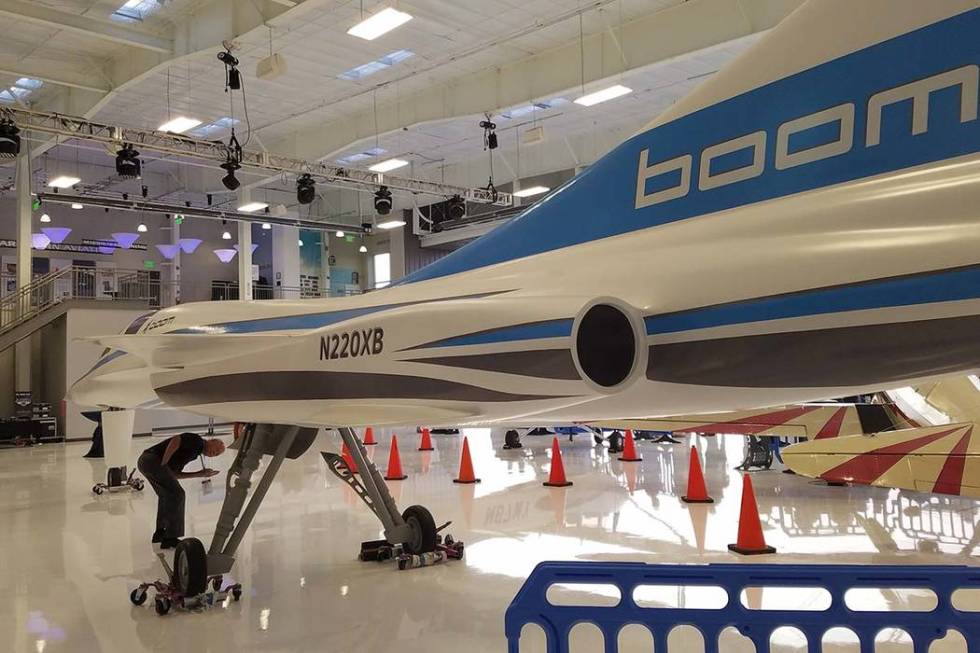Supersonic planes could change Las Vegas tourism, expert says

ENGLEWOOD, Colorado — Aviation industry leaders attending the 23rd annual Boyd Group International Aviation Forecast Summit got a glimpse of the future Saturday: Boom Supersonic presented a model of a test aircraft expected to lead to the return of speedy intercontinental travel.
And the head of the Colorado-based Boyd Group, aviation expert Mike Boyd, believes the plane could be game-changing for Las Vegas.
“A big chunk of them (Las Vegas visitors) are coming in to spend a lot of money,” Boyd said. “Do you think MGM Grand or Wynn wouldn’t want to charter an airplane like this for their high-rollers? In a New York second.”
Blake Scholl, who designed the aircraft and founded Boom in September 2014, said his airliner would be able to fly from Washington D.C. to London in 3½ hours instead of the more than seven hours it currently takes. San Francisco to Hawaii would take 2½ hours instead of five. Sydney, Australia, to Los Angeles could be completed in just under seven hours instead of just under 15.
Scholl’s whole premise for the 55-passenger airliner he hopes to get off the ground by 2025 is “removing the barriers to experiencing the planet” by transporting people in half the time it currently takes.
Baby boom
At a hangar at Centennial Airport in suburban Denver, early arrivals for the two-day Boyd conference saw a model of the XB-1, the first independently developed supersonic jet — and history’s fastest civil aircraft.
The XB-1 and Boom’s airliner will be flown at Mach 2.2 — 1,451 mph. With an all-business-class cabin and every seat with a large window and next to the center aisle
Scholl said the XB-1, known by company employees as “Baby Boom,” is a two-seat test vehicle that will enable the company to refine its airliner design, ensuring a passenger aircraft which is efficient, reliable and safe.
Parts of the aircraft are being manufactured with lightweight carbon composites in San Diego and transported to Denver for assembly in Boom’s hangar at Centennial Airport.
Scholl said Baby Boom would fly by the end of next year. Investors already have put in $41 million to complete the design and construction of the XB-1 with Richard Branson’s Virgin Atlantic and Japan Airlines among the first to invest.
Japan Airlines put $10 million into Boom and pre-ordered 20 aircraft. Chinese travel company Ctrip also has invested in Boom.
Flight tests will be conducted at Mojave Air & Space Port in Southern California, with supersonic flight tests in a flight corridor near Edwards Air Force Base.
Ban challenge
There are still plenty of obstacles to overcome. Scholl said a hard no-haggle pricetag of $200 million has been placed on every plane. A Boeing 777-300 jet can be purchased for about $180 million, he said.
There’s a political issue to overcome as well. The Federal Aviation Administration has banned supersonic flights in U.S. airspace. Unless that policy changes, Boom jets would have to slow to less efficient subsonic speeds once they hit a coastline and the potentially lucrative cross-country market couldn’t be tested.
Boyd said the fear is in potential damage created by sonic booms, the noise created when a vehicle travels faster than the speed of sound.
But Scholl said engineering designs in the aircraft and the relatively small size of the vehicle would minimize the sound.
Other environmental noise is more disruptive, said Boyd.
“Today, a (Boeing) 737 on approach into LaGuardia (International Airport) over Jackson Heights makes more noise than the sonic boom of this airplane,” Boyd said. “The trash truck that goes by your house at 6 a.m., that makes more noise. The problem is when you say sonic boom, everyone thinks of their Limoges china being blown away.”
Contact Richard N. Velotta at rvelotta@reviewjournal.com or 702-477-3893. Follow @RickVelotta on Twitter.